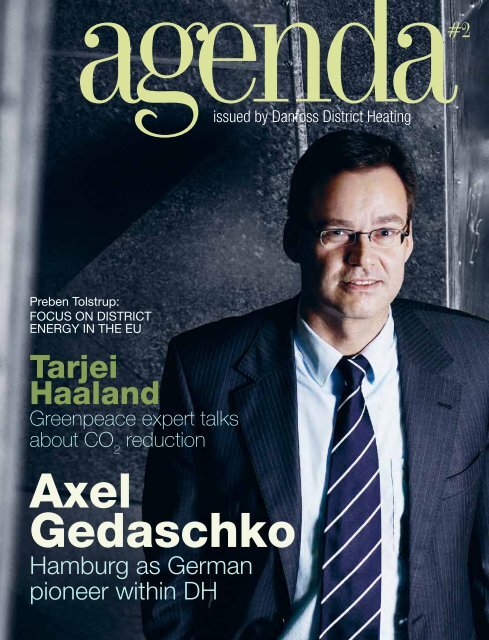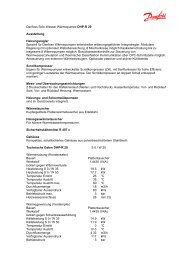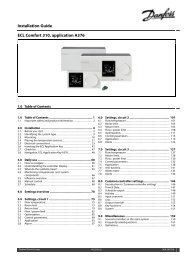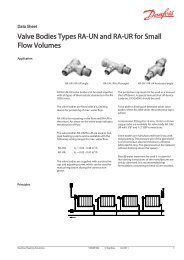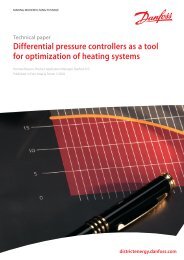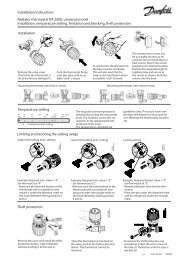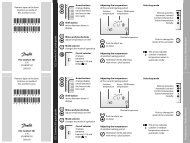Axel Gedaschko - Danfoss.com
Axel Gedaschko - Danfoss.com
Axel Gedaschko - Danfoss.com
Create successful ePaper yourself
Turn your PDF publications into a flip-book with our unique Google optimized e-Paper software.
Preben Tolstrup:<br />
focus on disTricT<br />
energy in The eu<br />
issued by <strong>Danfoss</strong> District Heating<br />
District heating by <strong>Danfoss</strong><br />
Tarjei<br />
Haaland<br />
Greenpeace expert talks<br />
about CO reduction<br />
2<br />
<strong>Axel</strong><br />
<strong>Gedaschko</strong><br />
Hamburg as German<br />
pioneer within DH<br />
#2<br />
#1
AGENDACONTENTS2008<br />
10<br />
Q&A<br />
Climate and energy expert<br />
from Greenpeace Tarjei<br />
Haaland shares his views on<br />
the economic and enviromental<br />
benefits of cogeneration and<br />
district heating.<br />
06 News<br />
<strong>Danfoss</strong> success in Italy, Poland<br />
and Hungary and lots of other<br />
exciting news from the local and<br />
global world of <strong>Danfoss</strong>.<br />
20 <strong>Danfoss</strong> World<br />
Dirk N. Ockhuizen elaborates on<br />
the effects of recent years’ flexible<br />
energy policies in the Netherlands.<br />
14<br />
Discussion<br />
District heating network<br />
should be massively<br />
extended in Hamburg.<br />
Academy<br />
District energy is one<br />
of the best-kept secrets<br />
in the energy world<br />
according to CEO of LOGS-<br />
TOR, Preben Tolstrup.<br />
26<br />
24 Solutions<br />
Tony Nielsen, Scandinavian Sales<br />
Director for <strong>Danfoss</strong> EnergyTrim,<br />
outlines the principle of the<br />
<strong>com</strong>pany’s service agreement.<br />
30 Gadgets<br />
A collection of smart ideas for<br />
business and pleasure.<br />
agenda 3
4 agenda<br />
HEATEDDEBATE<br />
Our biggest challenge is to extend the<br />
message about the efficiency and environmental<br />
benefits that district heating<br />
and cooling yields beyond the converted.<br />
Sharing knowledge and best-practice<br />
principles is key to creating greener and<br />
smarter energy systems – an issue on<br />
which we are at last globally united.<br />
Understanding how to utilise waste energy<br />
as a means to master energy optimisation<br />
is paramount. Research has<br />
demonstrated that big plants are more<br />
efficient and far less polluting than small<br />
plants, and that district heating is a valuable<br />
solution for utilising the untapped<br />
potential of waste energy.<br />
Industry must be motivated to take responsibility<br />
for waste energy and rethink<br />
it as a resource. Approximately 75% of<br />
the district heating in Denmark is a byproduct<br />
from producing electricity. It is my<br />
hope that this benchmark will continue to<br />
grow, and that it will set an example to<br />
other countries that strive to improve its<br />
energy systems.<br />
There is a trend for the world energy market<br />
to focus exclusively on renewable solutions.<br />
It is important for stakeholders to<br />
understand that district heating is a flexible<br />
infrastructure that can utilise, for example,<br />
biomass to great effect – not only<br />
in the future, but in the here and now.<br />
<strong>Danfoss</strong> takes its role in keeping district<br />
heating on the political agenda of future<br />
energy systems seriously. Not only because<br />
it is the cornerstone of our business,<br />
but because it is an effective way<br />
to tackle the challenges the world faces<br />
in terms of safeguarding our planet. We<br />
are not only working closer than ever<br />
locally with Danish politicians, but we<br />
are increasingly active in our efforts to<br />
help steer policymaking at EU level and<br />
prompt knowledge-sharing across borders.<br />
To this end, I am delighted that<br />
German Senator <strong>Axel</strong> <strong>Gedaschko</strong> contributes<br />
his voice to this edition. He helps<br />
delineate the political dimensions of district<br />
heating, as well as share the positive<br />
impact it has made as a growing energy<br />
solution in Hamburg.<br />
Our work on this front is also supported<br />
by positive contributions from environmental<br />
and pressure groups who share<br />
in our vision. We respect Greenpeace<br />
exploiting opportunities to generate<br />
knowledge and advocate positive action<br />
with such campaigns as the recent<br />
‘Decentralised energy – what are we<br />
waiting for?’ information film.<br />
I believe our attempts to switch people<br />
onto the benefits of district heating has<br />
gained momentum and is impacting<br />
change. The latest directives from the<br />
EU Commission re<strong>com</strong>mend district<br />
heating as a progressive and efficient<br />
energy system for new area developments.<br />
It is a re<strong>com</strong>mendation, not<br />
legislation. But it is a step in the right<br />
direction, and confirmation that our<br />
message is getting through.<br />
The <strong>Danfoss</strong> promise of ‘making modern<br />
living possible’ is a reality that drives all<br />
that we do. We are as faithful to creating<br />
environmentally efficient solutions that<br />
limit eco penalties as we are to developing<br />
technology that redefines <strong>com</strong>fort. In<br />
<strong>com</strong>bination, this affords us the ability to<br />
lead the industry and make a difference.<br />
Jan Matzen<br />
Vice President Sales,<br />
<strong>Danfoss</strong> District Heating<br />
#2<br />
#2, 2008. <strong>Danfoss</strong> A/S: <strong>Danfoss</strong> District Heating, 6430 Nordborg, Denmark, Tel +45 7488 2222, www.dh.danfoss.<strong>com</strong>.<br />
issued by <strong>Danfoss</strong> District Heating<br />
Editor: Tine Frandsen, tif@danfoss.<strong>com</strong>. Publisher: Weis & Co. ApS, Middelfartgade 17, 2100 Copenhagen Ø, Denmark, Tel +45 33 366 266, lars.weis@weis-co.uk.<br />
#1<br />
Art Director: Anna Ax. Copywriters: Rob Holder, Paul Barfoot, Frank Grotelueschen.<br />
District heating by <strong>Danfoss</strong><br />
Proof-reader: InterText | Mus & Pen. Printer: Arco Graphisk, Gemsevej 4, 7800 Skive, Denmark. Paper: 250/100 gr., CyclusOffset, Dalum Papir, Denmark.<br />
Agenda is distributed twice a year by <strong>Danfoss</strong>. Opinions expressed in this publication are those of the authors or persons interviewed, and do not necessarily reflect the views of <strong>Danfoss</strong> or Weis & Co.<br />
All rights reserved. Material may not be reproduced in any form without prior written permission. Unsolicited manuscripts, photographs and illustrations are not excepted. ’Agenda’ accepts no<br />
responsibility for such material sent to its office, and is not liable for loss or damage of such material. Agenda assumes no responsibility for printing errors.
A view from the top<br />
An elegant spiral staircase<br />
stretches from the ground<br />
floor of the headquarters<br />
building to a glassed-in room<br />
with a sweeping view of the<br />
entire <strong>Danfoss</strong> campus.<br />
agenda 5
News <strong>Danfoss</strong> highlights<br />
6 agenda<br />
Best iN show<br />
The annual AgfW (Arbeitsgemeinschaft<br />
fernwärme) conference<br />
is a key event in the industry<br />
calendar. As a major player in the market,<br />
danfoss will be exhibiting 80 m 2<br />
of heating solutions and technology at<br />
the supporting exhibition.<br />
New stakehold iN italy<br />
danfoss has been very active in italy, both in the sale<br />
of <strong>com</strong>ponents and delivery of stations, as well as<br />
developing a network of local partners and distributors.<br />
in order to consolidate our presence in one of the fastest<br />
growing european district heating markets, we are delighted to<br />
announce the opening of a sales office in Turin.<br />
ezio gagliardi will head up the sales force as sales Manager.<br />
he brings years of valuable experience and knowledge of dan-<br />
We anticipate that our hot water systems<br />
with Legionella protection will<br />
be a showstopper for delegates.<br />
Legiokill® products have set new<br />
standards in anti-Legionnaire solutions<br />
for domestic hot water, and danfoss<br />
is proud to present them following an<br />
acquisition of dMs Wasser-Wärmetechnik<br />
gmbh.<br />
Alongside, house and flat stations will be<br />
exhibited in conjunction with our portfolio<br />
of electronic and self-acting controllers,<br />
control systems and actuators.<br />
Make a date to visit us at the entrance<br />
of hall 4, 8–10 April 2008, Bremen<br />
exhibition & conference centre.<br />
further info: www.waermemesse.de<br />
foss’ products to the post, and he will be proactive in responding<br />
to the growing trend for flat stations.<br />
“The market is demanding more and more solutions alongside<br />
<strong>com</strong>ponents. our stations put us in a very strong position,<br />
and supported by a wide range of <strong>com</strong>ponents we are able to<br />
deliver <strong>com</strong>plete heating solutions for individual houses and<br />
apartments. This is a great opportunity for danfoss, and we<br />
have high expectations for our future in italy,” reports gagliardi.
streamliNed sales success<br />
iN polaNd<br />
danfoss LPM is pleased<br />
to report an increase<br />
in the quality and volume of its<br />
sales chain as part of the danfoss<br />
sales Program (dsP).<br />
during Q1 and Q2 of 2007, the<br />
danfoss LPM sales team created<br />
work streams to evaluate<br />
and improve key sales processes,<br />
and implement new<br />
sales tools. As a result it closed<br />
2007 an impressive 19% above<br />
target.<br />
opportunity Project Management<br />
has increased the <strong>com</strong>petitiveness<br />
of the <strong>com</strong>pany’s<br />
offers, while Pocket Margin<br />
analyses have helped eliminate<br />
surpluses after cost collection<br />
at the close of contracts for cus-<br />
tomised products.<br />
sales force efficiency has<br />
been improved by increasing<br />
direct selling time. This was<br />
made possible by repositioning<br />
70% of sales Managers’ quotations<br />
to the Technical sales<br />
support department, which<br />
is equipped with new website<br />
tools to enhance the flow and<br />
response rate of quotation and<br />
dimensioning enquiries.<br />
Work on micro-segmentation<br />
of Polish district heating utilities<br />
is ongoing and will provide<br />
a platform for us to align the<br />
whole <strong>com</strong>pany based on a<br />
value chain that will be responsive<br />
to customers, and increase<br />
danfoss LPM’s efficiency and<br />
profitability within the domestic<br />
<strong>Danfoss</strong> highlights News<br />
daNfoss equips<br />
huNgariaN homes<br />
széphő Zrt district heating<br />
<strong>com</strong>pany and széphő Ltd installation <strong>com</strong>pany<br />
recently collaborated on a 24-flat housing<br />
project costing in excess of 1.1 million euro as<br />
part of an initiative to increase residential property<br />
in the hungarian city of székesfehérvár.<br />
danfoss was <strong>com</strong>missioned to equip the new<br />
homes with a primary substation, 24 VMTdf-1<br />
flat stations and 24 TP7000 thermostats.<br />
A 600 litre-capacity buffer tank was also installed<br />
for the liquidation of the peak load.<br />
The heating and hot water system boasts<br />
minimal heatloss, low operational distribution<br />
costs, localised and accurate cost allocation<br />
and anti-Legionnaire technology.<br />
The Mayor of székesfehérvár praised the<br />
building project as a great example of how investment<br />
can raise the standard and volume<br />
of ac<strong>com</strong>modation in the city.<br />
agenda 7
News<strong>Danfoss</strong> highlights<br />
8 agenda<br />
record growth BriNgs<br />
daNfoss closer<br />
A growing number of european acquisitions by<br />
danfoss district heating has contributed to record<br />
growth and provided an opportunity to work more closely<br />
with local customers.<br />
The latest buy-in to the swiss <strong>com</strong>pany Proenergie Wärmetechnik<br />
marks the tenth corporate purchase in the last<br />
five years. danfoss has a steadfast team <strong>com</strong>mitted to<br />
strategically develop a portfolio of acquired <strong>com</strong>panies as<br />
<strong>com</strong>petence centres, as well as manage reinvestments and<br />
increase penetration of new markets.<br />
direct contact with customers in local markets and boosting<br />
production capacities on several local sites is key to<br />
strengthening danfoss’ ability to provide the right products<br />
at the right time. Being responsive to customers’ needs is<br />
as important as our <strong>com</strong>mitment to the quality and innovation<br />
of the district heating solutions we deliver.
watertight acquisitioN<br />
We are pleased to wel<strong>com</strong>e dMs Wasser-<br />
Wärmetechnik gmbh to the danfoss stable.<br />
A deal was sealed in Q3 of 2007 for danfoss<br />
to take over the <strong>com</strong>pany’s marketing, sales<br />
and technical services.<br />
in the last two decades dMs has be<strong>com</strong>e a<br />
centre of excellence in developing, producing<br />
and marketing anti-Legionnaire solutions<br />
for domestic hot water with integrated<br />
thermal disinfection of the circulating water.<br />
it has been particularly active in the german<br />
market, and made headway in Austria, italy<br />
and switzerland.<br />
“With this agreement, we will strengthen<br />
our already very successful business within<br />
<strong>com</strong>plete solutions for the domestic hotwater<br />
market. our ambition is to be a clear<br />
leader within this field and it is therefore vital<br />
for us to be at the forefront where the market<br />
is developing, such as in anti-Legionnaire<br />
solutions,” announced niels B. christiansen,<br />
danfoss’ Vice ceo.<br />
<strong>Danfoss</strong> highlights News<br />
improved coNNectioNs for<br />
cliNical ceNtre iN serBia<br />
it has been three years in the making, but a project<br />
to remodel the heating and hot water supply of<br />
serbia’s central medical facility, the clinical centre<br />
of serbia, is near <strong>com</strong>pletion.<br />
following a 2005 pilot, World Bank announced a<br />
tender in 2006 for the reparation and reconstruction<br />
of substations for the serbian hospital.<br />
collaborating with Projektomontaza as contractor<br />
and TrAco as installer, danfoss was <strong>com</strong>missioned<br />
to supply substations for the initiative.<br />
A total of 58 substations, with a capacity of 53MW<br />
for heating and 9.8KW for domestic hot water, will<br />
have been delivered and connected by <strong>com</strong>pletion<br />
of the project later this year.<br />
agenda 9
A Sensible Solution<br />
According to Tarjei Haaland, there is an overriding logic behind the<br />
cogeneration of heat and power, along with increased use of district heating.<br />
Taken together, these steps vastly increase efficiency and reduce waste<br />
and have wide-ranging economic and environmental effects. And, as the<br />
example of Denmark shows, cogeneration and district heating present an<br />
eminently achievable solution to CO 2 reduction and energy security.<br />
TExT ROB HOLDER, PHOTOS REIMAR JUUL<br />
District heating is mentioned in a<br />
variety of economic and environmental<br />
contexts. What is the key to<br />
its effectiveness?<br />
There are a lot of good things to say<br />
about district heating. It’s an essential<br />
part of cogeneration and an excellent<br />
way to harness the energy that goes to<br />
waste in power production. It’s simple,<br />
effective, environmentally friendly, easy<br />
to use and robust against fuel price variations.<br />
District heating is also very flexible,<br />
because you can heat up water in<br />
many ways – making room also for using<br />
solar and geothermal heat. Remember<br />
that basically what we’re talking about is<br />
delivering heat via a water-borne system<br />
– all you need to heat a house is 70-degree<br />
Celsius hot water.<br />
Is the use of district heating in Denmark<br />
useful as a model for energy reform in<br />
other countries?<br />
My experience and opinions are largely<br />
based on the Danish example. It’s a fact<br />
that Denmark is well in the lead when<br />
it <strong>com</strong>es to district heating – especially<br />
district heating as part of cogeneration of<br />
power and heating. Denmark is remarkable<br />
because it has managed to a large<br />
degree to “unbundle” rising GNP from<br />
energy use: unlike most other developed<br />
countries prime energy use has remained<br />
more or less constant since 1980, while<br />
GNP has increased by 75 percent. This<br />
is not only because district heating is so<br />
widespread in Denmark – delivering 60<br />
percent of the heat demand for 1.5 million<br />
houses – but also because about<br />
82 percent of district heat in Denmark is<br />
produced through cogeneration.<br />
So, Denmark holds a clear example of potential<br />
energy savings for other countries.<br />
A European study made by Euroheat &<br />
Power shows that district heating’s share in<br />
Tarjei Haaland Q&A<br />
Europe is only 9-10 percent, and that just<br />
doubling this would lead to a CO 2 reduction<br />
of 400 million tonnes a year – a reduction<br />
of nine percent <strong>com</strong>pared to today’s<br />
CO 2 emissions in Europe. Many European<br />
countries – Norway, Sweden, France and<br />
others – use a lot of direct electric heating<br />
for houses, a practice that Amory Lovins,<br />
an American energy expert, said years ago<br />
is about as efficient as “cutting butter with<br />
a chainsaw”. Using high-quality electricity<br />
– which should be used to power machinery,<br />
lighting and so on – for home heating<br />
is a tremendous waste.<br />
What are some of the specific benefits<br />
that could be realised by more<br />
widespread use of district heating?<br />
Greenpeace has developed a Nordic<br />
energy scenario. It shows that Norway,<br />
for instance, uses four times as much<br />
electricity per capita as Denmark. Sweden<br />
uses 2.5 times as much, and Fin-<br />
agenda 11
Q&A Tarjei Haaland<br />
12 agenda<br />
“In Denmark, district heating has been around so long and is so successful that<br />
it tends not to be discussed. It still has an important part to play, but there is a need<br />
for study and analyses of its role in a future with increased insulation in the existing<br />
building stock and the phase-in of new low- to zero-energy houses.”<br />
land is similar. Even when adjusted for<br />
Norway’s need for power to run certain<br />
industries, such as aluminium production,<br />
household use is four times that<br />
of Denmark. Why? Mostly because of<br />
their abundant hydropower, they use<br />
direct electric heat for their houses, as I<br />
mentioned earlier. This is certainly not a<br />
clever way of using electricity from existing<br />
hydro power.<br />
Our scenario explores the result of<br />
gradually replacing direct electric heating<br />
with water-borne district heating<br />
systems in towns. If that were to<br />
happen, then you set free lots of hydroelectricity,<br />
which could be used to<br />
replace nuclear power in Sweden and<br />
Finland and coal power in Denmark<br />
and Finland. There are a total of 14 nuclear<br />
reactors in the Nordic region – 10<br />
in Sweden and four in Finland. They<br />
produce an amount of electricity only<br />
slightly greater than what’s used today<br />
for direct electric heating of homes in<br />
the Nordic countries. So, as a theoretical<br />
example anyway, replacing direct<br />
electric heating with water-borne<br />
systems could eliminate the need for<br />
nuclear power in the region, and help<br />
reduce dependence on coal plants. It’s<br />
certainly not as simple as a one-to-one<br />
substitution, but these examples show<br />
you the potential of cogeneration and<br />
district heating in reforming future energy<br />
systems.<br />
Just converting existing power plants to<br />
cogeneration facilities would be a big step<br />
in the right direction. Typically, in most<br />
Nordic countries outside Denmark and<br />
throughout Europe, power plants produce<br />
only electricity. Many are located not far<br />
from towns and should be converted to<br />
cogeneration plants for district heating<br />
use. There are also many plants that produce<br />
only heat, and in Denmark many of<br />
these have been converted to cogeneration<br />
facilities. With cogeneration you save<br />
a tremendous amount of fuel over what it<br />
takes to produce heat and electricity separately.<br />
You increase efficiency, reduce CO 2
and decrease dependence on uncertain<br />
supplies of fossil fuel – from the Middle<br />
East and Russia, for example.<br />
What are some of the roadblocks to<br />
wider adoption of cogeneration and<br />
district heating?<br />
One big problem is that support for cogeneration<br />
in the recent EU <strong>com</strong>mission<br />
directive was weakened by opposition<br />
from major European electricity <strong>com</strong>panies,<br />
who want to produce only electricity.<br />
They’re definitely not allies when we<br />
talk about conversion to cogeneration<br />
and district heating. So from one point<br />
of view, it’s a struggle between big centralised<br />
electricity producers and local<br />
<strong>com</strong>munities who want a more sensible<br />
system. On a larger scale, you can see<br />
it as a question of government regulation<br />
versus the free market. If we continue accepting<br />
only the market as a driver, then<br />
politicians have to provide leadership.<br />
Either governments will have to make<br />
the market for cogeneration and district<br />
heating more economically interesting<br />
and secure for private investors, or make<br />
it more expensive to use traditional separate<br />
heat and power generation.<br />
Is it also a question of countries being<br />
unwilling to undertake the expense of<br />
switching to more efficient systems?<br />
Of course there are costs involved, but<br />
nothing like the costs of not switching<br />
over to more efficient systems. Nicholas<br />
Stern, a former chief economist for the<br />
World Bank, recently <strong>com</strong>piled a report<br />
for the UK government which projected<br />
that in the future it will cost between five<br />
and 20 percent of GNP to do nothing<br />
about climate change and about two<br />
percent of GNP to take action. In other<br />
words, it’s cheaper for society to act than<br />
to continue “business as usual”. The investment<br />
costs needed to reshape our<br />
energy systems to emit less CO 2 is more<br />
than <strong>com</strong>pensated by the saved costs of<br />
buying more and more expensive fossil<br />
fuels. Similar arguments can be applied<br />
to cogeneration and district heating. In<br />
Denmark this was handled through a<br />
Tarjei Haaland Q&A<br />
big infrastructure investment supported<br />
by the government in the 1980s, so the<br />
Danish example needs to be strongly<br />
used to make the point. It’s a bit of an<br />
uphill battle at this stage – it should be<br />
happening more quickly than what we’re<br />
seeing now.<br />
And remember that we’re not talking<br />
only about protecting ourselves against<br />
rapidly increasing fuel costs, especially<br />
oil, but also about the broader social<br />
and environmental impacts, such as<br />
CO 2 -produced climate change and the<br />
health effects of burning coal. These external<br />
costs are only marginally reflected<br />
in the price of coal, for example, which is<br />
why it continues to be used heavily, even<br />
though, were these costs factored in, it<br />
would be seen as the most expensive<br />
way to produce electricity. You can view<br />
this as a huge market failure, because<br />
the true costs aren’t internalised by the<br />
market – so what is needed is for governments<br />
either to tax dirty fuels more heavily<br />
or subsidise clean ones.<br />
agenda 13
DIsCUssION <strong>Axel</strong> <strong>Gedaschko</strong><br />
14 agenda<br />
Renaissance<br />
of district heating<br />
Compared with many other EU<br />
countries, district heating has<br />
been used only on a relatively<br />
small scale so far in Germany.<br />
The North German metropolis<br />
of Hamburg, with an extensive<br />
district heating network, is one<br />
exception. Those responsible,<br />
such as <strong>Axel</strong> <strong>Gedaschko</strong>, State<br />
Minister for Urban Development<br />
and Environment, plan to<br />
further expand district heating<br />
in the future as an environmentally<br />
friendly form of energy.<br />
TExT FRANK GROTELUESCHEN, PHOTOS MIKKEL STRANGE<br />
Hamburg – tHe DIstrIct HeatIng<br />
capItal of germany<br />
nineteen percent of all households in hamburg are supplied<br />
with district heating, <strong>com</strong>pared with the german average<br />
of only 8 percent. <strong>Axel</strong> gedaschko believes that the<br />
hamburg district heating network should be massively<br />
extended: “A new coal-fired power plant is to be built in our<br />
city and we have made it a condition that this power plant<br />
should generate significantly more <strong>com</strong>bined heat and power<br />
than originally envisaged by the energy supplier Vattenfall.<br />
in addition, Vattenfall is <strong>com</strong>mitted to massively extending<br />
the district heating distribution lines at a cost of around<br />
50 million euros. The new distribution lines will connect the<br />
districts of Wilhelmsburg and harburg in the south of hamburg.<br />
only small amounts of district heating are currently<br />
available in these areas and we hope to be able to connect an<br />
extra 25,000 to 30,000 homes. in addition, we plan to further<br />
consolidate the network in the north of hamburg. our aim<br />
is to connect a further 50,000 homes to the district heating<br />
network by 2020. This is a realistic goal.”
District heating plant<br />
at HafenCity Hamburg:<br />
With a thermal output of up to 300 megawatts, the district<br />
heating plant built in 1999 supplies district heating to<br />
parts of HafenCity. Situated in the former harbour area,<br />
this is a newly developed district of Hamburg with attractive<br />
offices, residential buildings and cultural facilities.
DIsCUssION <strong>Axel</strong> <strong>Gedaschko</strong><br />
16 agenda<br />
in terms of district heating use <strong>com</strong>pared with other eu<br />
countries, germany ranks in the middle of the eu-32<br />
and is therefore <strong>com</strong>pletely average. According to <strong>Axel</strong><br />
gedaschko, this is partly due to germany’s housing<br />
structure: “district heating lends itself particularly to large<br />
conurbations. The high capital costs make it less cost-<br />
effective in provincial areas. The average location of<br />
district heating systems in germany is also historically<br />
based, since a district heating system can’t just be built<br />
overnight, it simply doesn’t work like that.”<br />
tHe aDvantages of DIstrIct HeatIng<br />
for a long time district heating in germany was discredited<br />
as being more expensive than oil or gas. But this has<br />
now changed and today it is more reasonably priced. Although<br />
the capital costs for the district heating network<br />
are rather high, the variable costs have not risen as sharply<br />
in recent years as for gas and oil heating systems. <strong>Axel</strong><br />
gedaschko puts this down to the mix with which district<br />
heating is generated here in hamburg: “This mix is based<br />
mainly on coal and gas. in recent years, gas prices have<br />
risen sharply. if we want to absorb these costs, residents<br />
must accept coal-fired power stations to generate district<br />
heating. Vattenfall is planning to replace an old coal-fired<br />
power station in hamburg with a new, modern version. in<br />
our city this project is not without its critics, but because of<br />
the german federal government’s <strong>com</strong>mitment to phasing<br />
out nuclear energy, we must bite the bullet and permit<br />
coal-fired power plants for a further generation, with the<br />
proviso that cogeneration is significantly increased.” he<br />
is also quick to point out the additional positive spin-off:<br />
“Less cooling water from the power station goes into the<br />
elbe, more goes into the district heating network. And that<br />
is a very good idea.”<br />
district heating also contributes to climate protection: replacing<br />
oil or gas heating with a district heating connection<br />
will save on average 0.7 tonnes of co 2 emissions per<br />
household per year. district heating is therefore a very<br />
cost-effective way of saving considerable amounts of co 2 .<br />
energy mIx anD reDuceD energy consumptIon<br />
if you ask <strong>Axel</strong> gedaschko for his opinion on the correlation<br />
between district heating and the development of
“Our aim is to connect a further<br />
50,000 homes to the district<br />
heating network by 2020.<br />
This is a realistic goal.”<br />
new energy forms such as wind power, biomass and solar<br />
energy, he stresses that our first priority should be to try<br />
not to consume energy in the first place. “hamburg is the<br />
first of the 16 federal states to issue a climate Protection<br />
Act. it stipulates that a new building must consume 30<br />
percent less energy than currently authorised under federal<br />
law. We are now extending the act to include existing<br />
buildings: we aim to ensure that roof spaces are insulated<br />
and that single-glazed windows are replaced with doubleglazed<br />
windows. reducing energy consumption is the<br />
best way to reduce our impact on the environment.”<br />
The second point is the energy mix: “We are building a<br />
new quarter here in hamburg, the 150-hectare hafencity,<br />
on the banks of the elbe and right beside the city hall. We<br />
have held a europe-wide tender <strong>com</strong>petition for the supply<br />
of district heating to this quarter with an energy mix<br />
which includes renewables. i believe that this is where the<br />
future lies. Take hot water, for example: this can be supplied<br />
by solar energy. We have also installed a large fuel<br />
cell for supplying energy in the hafencity. it’s all down to<br />
the mix.”<br />
<strong>Axel</strong> <strong>Gedaschko</strong> DIsCUssION<br />
<strong>Axel</strong> <strong>Gedaschko</strong><br />
After the Abitur (the German higher education<br />
entrance qualification) in 1980 and military service<br />
in the German armed forces, <strong>Axel</strong> <strong>Gedaschko</strong> studied law in<br />
Hamburg and Göttingen. In 1988 he sat the first state bar<br />
exam, majoring in administrative law and public administration,<br />
followed by the second state bar exam in 1992.<br />
From 1993 to 2000 he was employed as Senior Legal<br />
Counsel for the state of Lower Saxony. In November 2000<br />
<strong>Gedaschko</strong> was elected as Principal Municipal Councillor<br />
(Erster Kreisrat) for the Harburg district and in 2003 he<br />
was elected as chief administrative officer. In 2006 Ole von<br />
Beust, First Mayor of Hamburg, appointed him Councillor<br />
of State for Urban Development and Transport in Hamburg.<br />
In January 2007 he became the State Minister for Urban<br />
Development and Environment. <strong>Gedaschko</strong>’s main political<br />
priorities concern how Hamburg can face up to the challenges<br />
of climate change and its repercussions, including<br />
the expansion of the district heating system and the pivotal<br />
role of CO 2 reduction strategies. The 48-year-old is a father<br />
of two and a member of Germany’s Christian Democratic<br />
Union (CDU).<br />
agenda 17
DIsCUssION <strong>Axel</strong> <strong>Gedaschko</strong><br />
18 agenda<br />
“It is now largely down to the energy<br />
producers not to abuse their market<br />
position. In Germany we have a<br />
regulatory system for the power and<br />
natural gas grids. We need something<br />
similar for district heating, too.”<br />
district heating can also help to ensure that germany<br />
achieves the eu emission targets for co 2 . When redeveloping<br />
any urban area, urban planners must always bear<br />
in mind the expansion of the district heating system. And<br />
when building new power plants it must be ensured that the<br />
heat produced is used via cogeneration to produce district<br />
heating. <strong>Axel</strong> gedaschko believes that “there is no other<br />
way to achieve the associated increase in efficiency. if we<br />
increase the insulation in our homes at the same time, we<br />
will need less district heating in these houses. That means<br />
that in the future we will be able to supply considerably<br />
more homes with the same total volume of district heating”.<br />
tHe Image of DIstrIct HeatIng In germany<br />
in the past, district heating had a negative image due to<br />
its <strong>com</strong>paratively high cost to the end consumer. for this<br />
reason, district heating was not particularly popular in<br />
germany. <strong>Axel</strong> gedaschko is convinced that the time is<br />
now ripe for a renaissance in district heating, provided<br />
that those responsible take the opportunity. “it is now<br />
largely down to the energy producers not to abuse their<br />
market position. in germany we have a regulatory system<br />
for the power and natural gas grids. We need something<br />
similar for district heating, too. only then can other<br />
suppliers <strong>com</strong>pete alongside the current energy provider.<br />
for example, in hamburg many industrial firms generate<br />
heat, which could also be fed into the district heating network,<br />
thereby reducing co 2 emissions. it is just a matter<br />
of giving these producers access to the district heating<br />
networks and paying them the true market value of the<br />
thermal energy, rather than a dumping price. We are still<br />
some way off from making this a <strong>com</strong>petitive market.”<br />
According to gedaschko, the cost of constructing district<br />
heating networks has been the main impediment to the<br />
expansion of district heating to date. “since buildings will<br />
be better insulated in the future and will therefore require<br />
less district heating, we must assume that the share of<br />
network costs <strong>com</strong>pared with consumption costs will increase.<br />
The challenge to engineers, therefore, is to develop<br />
processes which will enable district heating pipelines<br />
to be laid in the most cost-effective way possible. in addition,<br />
municipalities must design the pipeline wayleaves in<br />
such a way that they are acceptable to those building the<br />
pipelines. This means that the municipalities should not<br />
act to drive up the price. And finally, reliable state funding,<br />
as currently scheduled by the federal government, must<br />
be provided in the long term. After all, district heating is a<br />
long-term <strong>com</strong>mitment and one or two-year funding programmes<br />
are of little use.”
<strong>com</strong>mItteD to a future WItH DIstrIct HeatIng<br />
<strong>Axel</strong> gedaschko is personally <strong>com</strong>mitted to forging ahead<br />
with the expansion of district heating. “We have specifically<br />
ensured that Vattenfall significantly increases the amount<br />
of cogeneration at the new coal-fired power plant in hamburg:<br />
from the original 450 megawatts (MW) to 650 megawatts<br />
(MW).”<br />
With regard to the statutory framework requirements, he<br />
refers to the current draft bill on cogeneration, which could<br />
<strong>com</strong>e into force this year. This draft provides for state funding<br />
to subsidise the expansion of district heating. “since<br />
other sources of energy, such as solar or wind energy, are<br />
heavily subsidised, it would be a fatal distortion of the market<br />
if district heating were allowed to fall by the wayside.<br />
for this reason i believe it is right to use state funding with<br />
the aim of extending district heating. in terms of figures,<br />
this means that the federal government will subsidise <strong>com</strong>bined<br />
heat and power generation in the future to the tune of<br />
up to 750 million per year. And that also includes subsidies<br />
for constructing the district heating networks. i think this is<br />
the right way forward,” explains <strong>Axel</strong> gedaschko.<br />
he is convinced that district heating via cogeneration<br />
will undergo a renaissance. “With the right energy mix, it<br />
could even be a little cheaper than gas heating. on bal-<br />
<strong>Axel</strong> <strong>Gedaschko</strong> DIsCUssION<br />
ance we will need less energy for heating, because europe<br />
as a whole is investing massively in home insulation. consequently,<br />
although total sales of district heating will not<br />
increase dramatically, its percentage share of the heating<br />
supply should increase. The cost of the networks will be<br />
crucial to the economic success of district heating,” concludes<br />
<strong>Axel</strong> gedaschko.<br />
Hamburg<br />
With just under 1.8 million inhabitants, Hamburg is Germany’s<br />
second largest city and the seventh largest in the EU. The<br />
Hanseatic city is an autonomous city state and one of the 16 German<br />
federal states. Hamburg’s first district heating pipelines were constructed<br />
as early as 1893 and the city currently has a district heating<br />
network which extends to 740 km and supplies 410,000 homes. The<br />
<strong>com</strong>bined heat and power system (cogeneration) generates 1,450<br />
megawatts of heat and 450 megawatts of electricity.<br />
agenda 19
DANFOss wOrlD The Netherlands<br />
Macro benefits from<br />
micro-networks<br />
20 agenda
The Netherlands DANFOss wOrlD<br />
The Netherlands is known for its strong <strong>com</strong>mitment to maximising the<br />
benefits of a wide range of energy technologies. Dirk N. Ockhuizen,<br />
Director, AGH Warmte-units b.v – Member of the <strong>Danfoss</strong> Group, provides<br />
a look at the economic and environmental advantages of <strong>com</strong>bining heat<br />
pumps and district heating in micro-networks such as the one <strong>Danfoss</strong><br />
recently <strong>com</strong>pleted for a <strong>com</strong>munity of 200 homes in The Hague.<br />
TExT ROB HOLDER, PHOTO DEN HAAG MARKETING & EVENTS/ARJAN DE JAGER<br />
agenda 21
DANFOss wOrlD The Netherlands<br />
22 agenda<br />
A prime example of enlightened and flexible energy policies in<br />
the Netherlands is the liberalisation of energy laws, which effectively<br />
deregulated the way energy is bought and sold. Previously,<br />
consumers had no choice when buying energy. Under the new<br />
laws, anyone – from major purchasers to individuals – is free to<br />
buy electricity and gas from any Dutch power supplier. This frees<br />
<strong>com</strong>panies or even small groups of individuals to build their own<br />
micro-networks for heating and energy, since they are no longer<br />
tied to a specific power supplier. “A builder can use whatever<br />
energy <strong>com</strong>pany provides the best price,” says Ockhuizen,<br />
“then supply a self-contained substation to provide heating,<br />
cooling and hot water. This is ac<strong>com</strong>plished with a <strong>com</strong>bination<br />
of heat pumps and district heating via micro-networks that can<br />
serve a wide range of environments, such as neighbourhoods,<br />
multi-residential dwellings, shopping centres, hotels and hospitals.<br />
The substation installation includes heat pumps, boilers,<br />
storage tanks and controllers. It’s a self-contained local solution<br />
that provides turnkey energy plus heating and cooling – all the<br />
builder needs is a power plug and gas supply.”<br />
a WInnIng <strong>com</strong>bInatIon<br />
The <strong>com</strong>bination of energy supply with heat pumps and district<br />
heating offer significant economical and environmental advantages,<br />
and the Netherlands offer an ideal location to realise<br />
them. The concept of district heating – which increases energy<br />
efficiency by using a local distribution network of insulated<br />
pipes to deliver cheap and reliable heat or cooling from a central<br />
source – is well established there. Likewise, because of an<br />
easily accessible supply of 15-18 degree Celsius groundwater<br />
not far below the surface, the Netherlands offers excellent opportunities<br />
for utilisation of heat pumps. The heat pump system<br />
– which can also utilise heat energy from bedrock, earth, air or<br />
lake water – provides an economical and efficient way to control<br />
temperatures for both heating and cooling.<br />
Simply put, a groundwater heat pump collects energy from<br />
the groundwater. The water is pumped up from a groundwater<br />
borehole to a heat exchanger, where the energy is recovered.<br />
The water is then discharged back through another borehole.<br />
Heat pumps don’t take up much space, need no maintenance<br />
or fuel and offer an energy-efficient solution that saves money<br />
– up to 50 percent of heating costs – <strong>com</strong>pared with traditional<br />
heating systems. In fact, the homeowners on groundwater systems<br />
in the Netherlands pay only for heating. Cooling is essentially<br />
free, as the 15-18 degrees Celsius groundwater can<br />
be used for summer cooling: the only cost is for power to run a<br />
circulation pump – a strong sales point for home builders.<br />
Heat pump basics<br />
A heat pump is a device that warms or cools a<br />
building by transferring heat from a relatively<br />
low-temperature reservoir to one at a higher temperature.<br />
Heat pumps demonstrate great versatility in<br />
providing both air conditioning and heating in the same<br />
system by simply reversing the direction of flow of the<br />
working fluid circulating through the coils. In this regard,<br />
heat pumps eliminate the need for dual systems in order<br />
to maintain a desired temperature. Heat pumps all have<br />
the same basic <strong>com</strong>ponents: a pump, a condenser, an<br />
evaporator, and an expansion valve. The typical heat<br />
pump operation uses the working fluid to receive heat<br />
from a source positioned close to the evaporator. At the<br />
evaporator, the fluid vapourises into a low pressure vapour.<br />
Upon entering the pump, the vapour is <strong>com</strong>pressed<br />
to high pressure and enters a condenser which returns<br />
the vapour to a liquid and ultimately gives off its stored<br />
heat to the desired source. An expansion valve then allows<br />
the system to return to its low pressure liquid state,<br />
and the cycle begins again.<br />
It is just this <strong>com</strong>bination of efficiencies that <strong>Danfoss</strong> helped<br />
supply to a newly built neighbourhood of 200 homes near The<br />
Hague. These new houses were built in an area of older houses<br />
from the 1950s, which receive district heat from Eneco, one of<br />
three major power suppliers in the Netherlands. This project,<br />
however, was sponsored by Nuon, a <strong>com</strong>petitor of Eneco.<br />
Because of the liberalisation of energy laws described earlier,<br />
Nuon is able to buy gas and electricity from a <strong>com</strong>petitor in<br />
order to create a more economical and <strong>com</strong>petitive micronetwork<br />
solution. “<strong>Danfoss</strong> was a natural choice as a supplier<br />
for a project like this,” says Ockhuizen. “We’re one of the few<br />
<strong>com</strong>panies able to offer a <strong>com</strong>prehensive range of products for<br />
applications within district heating involving distributor stations,<br />
<strong>com</strong>mercial substations and single-family house substations as<br />
well as heat exchangers and automatic controls. <strong>Danfoss</strong> was<br />
the first <strong>com</strong>pany to <strong>com</strong>bine district heating and heat pumps<br />
into a single unified business unit, so we’re able to provide all<br />
necessary <strong>com</strong>ponents required for domestic heating, cooling<br />
and hot water. Through our Comfort Division we can even sup-
ply products for the interior of homes, such as radiator thermostats<br />
and floor heating.”<br />
far-reacHIng benefIts<br />
The micro-network concept provides numerous and farreaching<br />
economic and environmental benefits. As a signatory<br />
to the Kyoto Accord, an international treaty whereby<br />
countries agree to reduce the amount of greenhouse gases,<br />
the Netherlands has imposed regulations requiring that new<br />
buildings meet certain environmental standards, which are<br />
measured in terms of an energy performance coefficient<br />
(EPC). “Micro-networks <strong>com</strong>bining heat pumps and district<br />
heating are an excellent way to meet EPC requirements, not<br />
just because of heating and cooling efficiency of heat pumps,<br />
but also because of electricity savings provided by district<br />
heating,” says Ockhuizen. “Because district heating employs<br />
waste energy in the form of heat from power plants, there<br />
is a huge positive effect on both EPC and environment, so<br />
district heating is be<strong>com</strong>ing increasingly popular in the Neth-<br />
engIne<br />
electrIcIty<br />
HEAT IN HEAT OUT<br />
EVAPORATOR<br />
<strong>com</strong>pressor<br />
2.<strong>com</strong>pressIon<br />
1.evaporatIon 3.conDensatIon<br />
4.expansIon<br />
expansIon valve<br />
The Netherlands DANFOss wOrlD<br />
CONDENSOR<br />
erlands. Of the 50,000-60,000 new homes built annually, the<br />
majority are served by district heating systems because of<br />
the lower EPC rating.”<br />
According to Ockhuizen, there is a rapidly growing demand for<br />
such solutions in the Netherlands, and even large construction<br />
<strong>com</strong>panies and builders are developing micro-network<br />
systems as a way to build market share. Supported by the liberalisation<br />
of energy policies, this has created increased <strong>com</strong>petition<br />
within the energy market and has helped to control<br />
and even reduce energy prices. Also, because district heating<br />
systems can draw on a wide range of energy sources, including<br />
wind, solar power and biomass, micro-networks fit in well<br />
with the trend in the Netherlands toward small-scale simultaneous<br />
production of heat and power. Therefore, there’s an<br />
incentive for investment <strong>com</strong>panies to put money into renewable<br />
energy projects for use in micro-networks. The end result<br />
is energy savings and reduction of CO 2 emissions: a clear<br />
case of macro results from micro-networks.<br />
agenda 23
sOlUtIONs EnergyTrim<br />
24 agenda<br />
Less is more – time to trim<br />
Tony Nielsen, Scandinavian Sales Director for <strong>Danfoss</strong> EnergyTrim,<br />
outlines the principle of the <strong>com</strong>pany’s service agreement that is yielding<br />
a 15-25% savings return on a minimum investment for customers,<br />
and highlights that efficient energy consumption requires knowledge,<br />
<strong>com</strong>mitment and action from all responsible parties.<br />
TExT PAUL BARFOOT, PHOTO THOMAS OLESEN, HARTLY & MøLLER<br />
mInImal Investment, maxImum savIngs<br />
<strong>Danfoss</strong> EnergyTrim debuted on Danish shores just over one year<br />
ago, and although only currently available to Danish customers,<br />
its success has prompted plans to explore possibilities of how it<br />
could be tailored to other markets in the future. Despite being in<br />
its infancy, it belongs to a pedigree of expert knowledge within<br />
the district heating sector, and has quickly set new standards in<br />
energy efficiency for Danish municipals, housing associations and<br />
small- to medium-sized <strong>com</strong>panies.<br />
The EnergyTrim package optimises existing heating systems<br />
with on-going assessments, fine-tuning and proposals for<br />
possible changes of defective or tired <strong>com</strong>ponents that <strong>com</strong>promise<br />
optimal energy efficiency. It <strong>com</strong>es with a promise to<br />
slice customers’ energy bills by up to a quarter with a modest<br />
investment that in some cases has been redeemed by savings<br />
within as little as two months.<br />
“Most installations are in good order, but they are not adjusted<br />
correctly. synchronising a weather <strong>com</strong>pensator in line with a labour<br />
force or inhabitants can generate substantial savings, as can<br />
adjusting balancing valves and pumps so that heat input is accurate.<br />
An efficient cooling of the district heating water and the<br />
stability of the temperature control is also very important. There<br />
are many energy consultants within the district heating sector, but<br />
the difference between them and what EnergyTrim delivers is financial<br />
savings that can be felt almost immediately,” explains Tony<br />
Nielsen, Scandinavian Sales Director for EnergyTrim.<br />
long-term vIeW, contInuous effIcIency<br />
“One-off servicing falls short in adapting to things like improved<br />
insulation or a turnover of users. Such variables necessitate on-<br />
going assessments and adjustments to ensure that optimum energy<br />
efficiency is maintained. If we deliver a 25% energy saving<br />
over three on-site visits and return a year later, it is almost guaranteed<br />
that the customers’ energy consumption is back to where<br />
they started because an inexperienced third party has made<br />
changes to the system or a valve has be<strong>com</strong>e defective. It only<br />
takes one defective valve for energy consumption to escalate,<br />
and that’s why an on-going service agreement is important. One<br />
thing is achieving immediate energy savings, another is to remain<br />
responsive to changes in order to maintain it and make continual<br />
improvements,” continues Nielsen.<br />
real-tIme package, aDDItIonal benefIts<br />
Understanding that some customers require an advanced level<br />
of control and security for their installations, EnergyTrim Plus links<br />
weather <strong>com</strong>pensators to an energy-monitoring portal via web<br />
access so that heat, water and electricity consumption can be<br />
captured in real-time, and many assessments and adjustments<br />
can be performed automatically and remotely. Furthermore, it allows<br />
budget parameters to be set and warning alerts for overspends<br />
to be generated.<br />
unDerstanDIng energy beyonD <strong>com</strong>fort<br />
Take-up of EnergyTrim has generally exceeded expectations, but<br />
the biggest barrier is that it is a new concept that requires customers<br />
to rethink efficiency.<br />
“Customers trust the <strong>Danfoss</strong> brand and believe in the saving<br />
promise, but it is a sector that is traditionally conservative. It is<br />
very slow to adopt new ways of operating, and there is a tendency<br />
to stick with what they know. In addition, many do not<br />
understand efficiency beyond <strong>com</strong>fort. A system may provide a<br />
<strong>com</strong>fortable level of heating and hot water, but it does not mean<br />
it is the most economical or environmentally friendly. There is<br />
a long way to go to turn people on to rethinking what energy<br />
efficiency really means. We are now at a stage where we are<br />
documenting how customers are making substantial all-round<br />
savings, and this has been a powerful tool in switching people<br />
on,” acknowledges Nielsen.
Sales representative Bjarne Kjærulff<br />
and one of the cars<br />
eco value<br />
While the financial rewards of EnergyTrim are clear, customers<br />
should not underestimate the environmental benefits of an energy<br />
efficient system. It is an issue that is at the top of the global agenda,<br />
and there is the hope that buy-in to services like EnergyTrim<br />
is a benchmark that environmental responsibility is trickling down.<br />
“Unfortunately not. We recently conducted around 25 interviews<br />
with customers, and all of them revealed costsavings as their key<br />
driver. Second to this was security. Most customers think that being<br />
environmentally friendly and achieving an energy mark ‘A’ is a<br />
valuable add-on, but it’s not a key driver yet,” reveals Nielsen.<br />
retHInkIng tHe future, toDay<br />
Alternative energy such as wind and solar power has a key role<br />
within future energy systems, but EnergyTrim advances efficiency<br />
immediately.<br />
“Renewable energy is important, but targets set for 2020 are<br />
20% in the EU and 30% in Denmark. That means 70–80% will<br />
still be fossil fuels, and if we can trim the use, cost and negative<br />
environmental impact of these by 25%, that’s a lot! It is important<br />
to pick the low hanging fruits now. This is the message that we<br />
are trying to get through with PR and continuous dialogue with<br />
politicians and KOLs that have the power to translate it into policymaking.<br />
Legislation and accountability are important, but they<br />
are not enough,” asserts Nielsen.<br />
EnergyTrim sOlUtIONs<br />
District heating utilities are now required to save 1% annually<br />
via their end consumer. This is a step in the right direction,<br />
and many are now collaborating with <strong>Danfoss</strong> to promote<br />
EnergyTrim to customers as a means to achieve it.<br />
“I have been in discussion with the Ministry of Energy to advocate<br />
mandatory service agreements for buildings over a certain<br />
size. This would have a huge impact. They are of course only as<br />
good as the level of expertise with which they are being administered,<br />
and it is a very <strong>com</strong>plicated process to benchmark and<br />
police standards. But as a <strong>com</strong>pany we are <strong>com</strong>mitted to leading<br />
by example, doing whatever we can to proactively maintain our<br />
business as a political issue and share knowledge with customers<br />
in the hope that we can continue to take the right steps forward,”<br />
concludes Nielsen.<br />
For further information, visit www.energytrim.dk<br />
eNergytrIm hOt FACt: 130,000 DKK saved in five<br />
months! In less than half a year, Lind Furniture in Thorning<br />
trimmed its gas consumption by 16, 300 cubic metres<br />
and achieved a financial saving of 130,000 DKK with<br />
EnergyTrim. Renovating the <strong>com</strong>pany’s heat control system and<br />
continuous optimal adjustments cost Lind Furniture 50,000 DKK,<br />
which was returned two and a half times over in just five months.<br />
“Savings have be<strong>com</strong>e a sport for us all,” announced the <strong>com</strong>pany’s<br />
Building Manager Lars Maretti.<br />
agenda 25
ACADemy Trends<br />
A proven solution with<br />
big potential<br />
26 agenda<br />
“District energy is one of the best-kept secrets in the energy<br />
world,” says Preben Tolstrup, CEO of LOGSTOR. Together with<br />
corporate leaders from <strong>Danfoss</strong>, Grundfos and the consulting<br />
<strong>com</strong>pany COWI he’s working to change this situation.<br />
TExT ROB HOLDER, PHOTOS MIKKEL STRANGE<br />
It’s been around for decades. It not only works, it works remarkably<br />
well. It’s been one of the driving forces behind Denmark’s enviable energy<br />
efficiency record. So why isn’t district energy one of the leading<br />
options on the EU – and worldwide – energy agenda? A conversation<br />
with Preben Tolstrup makes it clear that the answer may be that, in<br />
an era enchanted by the idea of breakthrough technologies, district<br />
energy is either not being fully understood by many European politicians,<br />
or is simply not “sexy” enough.<br />
Which is why the leaders of four prominent Danish corporations became<br />
especially concerned when first drafts of new EU energy directives<br />
made no mention of district energy. So concerned that they<br />
collaborated on a white paper* clarifying district energy’s practical advantages<br />
and environmental promise. “We had to take the initiative,”<br />
says Tolstrup, “not only with the white paper, but also through direct<br />
contact with officials in Brussels and industry groups, such as the European<br />
Business Forum.”<br />
loWerIng consumptIon<br />
One of the main points of the white paper is that the “easiest” way<br />
of reducing CO 2 emissions is simply to lower energy consumption<br />
by be<strong>com</strong>ing more energy efficient. A point that be<strong>com</strong>es even<br />
more powerful in light of the fact that more than one third of the<br />
energy supplied to the EU-32 countries in 2003 was lost and never
Glass jars with different<br />
coloured contents offer<br />
a graphic representation<br />
of the many ways district<br />
energy can preserve and<br />
<strong>com</strong>bine energy.<br />
Trends ACADemy
ACADemy Trends<br />
28 agenda<br />
delivered to energy end users. This waste of energy alone<br />
makes it important to recall that the fundamental idea of<br />
district energy is to make use of local fuel, heat or cooling<br />
sources which would often otherwise be wasted. District energy<br />
makes much greater efficiency possible by using a local<br />
distribution network of insulated pipes, which provide for a<br />
cheap and reliable heat or cooling source.<br />
It’s also important to remember that district energy systems<br />
are essentially <strong>com</strong>mon carriers for a wide range of energy<br />
sources. District energy is a multifuel system: any type of<br />
available energy, whether “black” or “green” can be used –<br />
from coal, oil and gas to wind, solar power and biomass – or<br />
stored for future use.<br />
“Even materials such as industrial or household waste products<br />
are increasingly being utilised as fuel for district energy,<br />
which also helps resolve other environmental problems, like<br />
waste dumping,” says Tolstrup. “It’s not at all far-fetched to<br />
envision a future in which many stand-alone systems, including<br />
wind and geothermal systems, will be parts of a tightly<br />
linked district energy network – what I’d call an intelligent<br />
energy system – where each energy source will help balance<br />
and optimise both energy supply and energy efficiency.”<br />
reDucIng emIssIons<br />
Most importantly, district energy has been thoroughly proven<br />
through years of experience in many countries. In Sweden,<br />
Denmark and Finland, for example, more than 50% of the<br />
population use district energy today. District heating has already<br />
made a start at helping to reduce CO 2 emissions. At
the end of the 1990s the International Energy Agency estimated<br />
that district heating was reducing global CO 2 emissions<br />
by 3-4% (700-900 million tonnes). A doubling of the<br />
current 6% district heating share of the EU-32 countries to<br />
12% would result in an estimated reduction of 400 million<br />
tonnes of CO 2 – the equivalent of the entire emissions from<br />
fuel <strong>com</strong>bustion in France. It would also significantly lower<br />
import dependency and dramatically increase energy efficiency.<br />
District cooling, for instance, is 5-10 times more efficient<br />
than traditional cooling solutions, such as electrically<br />
powered air-conditioning (AC) systems.<br />
Preben Tolstrup acknowledges that CO 2 reduction and increased<br />
energy efficiency are <strong>com</strong>plex issues. “As both oil<br />
prices and energy demand continue to rise and environmental<br />
concerns multiply there’ll be increased pressure for<br />
change,” he says. “It seems obvious that district energy can<br />
play an important part. Politicians have to take the lead – for<br />
example, through redesigned tax laws that move the focus<br />
from simply generating revenues to providing energy incentives.<br />
But we all need to do a better job of “branding” district<br />
energy, of getting the message out that it’s one of the best,<br />
most readily available solutions we have to a whole range of<br />
energy and environmental problems. I’m an optimist – I believe<br />
that doubling our use of district energy within the next<br />
10 years is absolutely doable.”<br />
*To read the “White Paper on District Heating and<br />
District Cooling Solutions in an Environmental Perspective”<br />
go to www.dh.danfoss.<strong>com</strong>/agenda<br />
District Energy involves<br />
production of steam, hot water or chilled<br />
water, or any <strong>com</strong>bination including all three, at a<br />
single central utility plant for distribution to other<br />
buildings through a network of pipes. District<br />
energy systems are essentially <strong>com</strong>mon carriers<br />
for a wide range of energy sources. Any type of<br />
available energy – from coal, oil and gas to wind,<br />
solar power and biomass – can be used for heating<br />
and cooling buildings or stored for future use.<br />
In a cogeneration plant the core element is that<br />
both electricity and heat/cooling is generated in a<br />
<strong>com</strong>bined process, bringing the energy efficiency<br />
to more than 90%, from around 40% producing<br />
electricity on a stand-alone basis.<br />
The <strong>com</strong>bination of cogeneration and district<br />
energy is very energy efficient. A steam-electric<br />
power plant which generates only electricity<br />
can convert only up to 47% of the fuel input into<br />
electricity. The major part of the energy is wasted in<br />
form of heat and dissipated to the environment. A<br />
cogeneration plant recovers that heat and thus has<br />
a degree of efficiency of around 90%.<br />
Trends ACADemy<br />
agenda 29
gADgets Smart Ideas<br />
eNergy-saviNg power cutter<br />
standby functions use up to 70% of the power required of TVs, dVd players,<br />
games consoles, home theatres and hi-fis that are switched on. Put an end<br />
to unnecessary standby energy guzzling with a Power safer. you never need<br />
to unplug your TV again as it disconnects the standby mode from the power<br />
supply via your remote control. simply plug and go, and the Power safer will<br />
reduce your energy bill and extend the life of your equipment by up to 15%.<br />
www.doctorenergy.co.uk<br />
glowiNg Nights<br />
Light up your evenings with this long-life, energy-smart<br />
night light. The light-emitting diode has a durability of<br />
50,000 virtually heat-free hours that will illuminate your<br />
dark hours. savings from its very modest 2W power<br />
consumption will also be felt in your pocket. Plug it<br />
in and enjoy a warm, radiant, dazzle-free light <strong>com</strong>e<br />
dusk. At dawn the light switches off automatically.<br />
www.conrad.se<br />
30 agenda<br />
a Bright charge<br />
using Mother nature to charge us up is a resourceful concept. The<br />
freeloader solar charging system uses sun rays to fuel all your gadgets<br />
and gizmos. fully charged, the internal battery can provide 18 hours of<br />
playtime for an iPod, 2.5 hours of gaming for a PsP and 44 hours<br />
of talktime for a mobile phone. With a capacity to hold its<br />
charge for up to three months, impact-resistance and<br />
sleek aesthetics – it’s an energising must-have.<br />
www.solartechnology.co.uk<br />
log oN to a c02-frieNdly future<br />
initiatives to fight global warming have created a growing number of tools to<br />
help manage and reduce c02 pollution. The danish Ministry of the environment<br />
and Ministry of Transport and energy have launched an online portal as<br />
part of the ‘1 ton mindre’ (1 tonne less) campaign. Visit www.1tonmindre.dk to<br />
measure and limit your toxic emissions with a c02 calculator. similarly, the german<br />
website www.co2online.de is dedicated to motivating private households,<br />
trade and <strong>com</strong>merce to be proactive in climate protection, with practical advice<br />
on reducing energy costs. The first step to a greener future is at your fingertips.
MAKING MODERN LIVING POSSIBLE<br />
Start the dialogue today<br />
Find agenda on <strong>Danfoss</strong> Heating Portal<br />
We are the only <strong>com</strong>pany worldwide<br />
supplying substations as well as automatic<br />
controls for the district heating<br />
market. Over the years we have gathered<br />
masses of experience by working<br />
under all kinds of conditions and with<br />
many different heating systems.<br />
Read Agenda online!<br />
You will find more articles here:<br />
www.dh.danfoss.<strong>com</strong>/agenda


